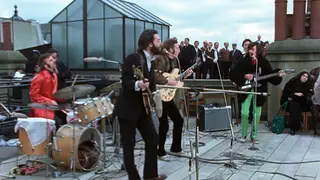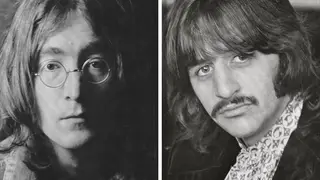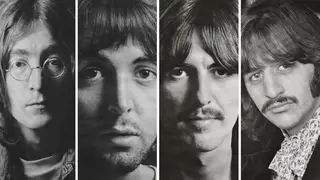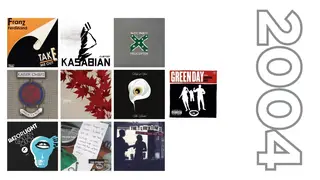Why Magical Mystery Tour was considered The Beatles' Boxing Day flop
26 December 2024, 14:00 | Updated: 29 December 2024, 13:53

"Rubbish", "boring" and "appalling": just three of the word used to describe the Fab Four's self-produced TV movie, which aired on Boxing Day 1967. But why did the film get that sort of reaction?
Listen to this article
The Daily Mirror called it "rubbish". The Daily Express said it was "boring". The Daily Mail's TV critic said it was "appalling". This was The Beatles' Magical Mystery Tour - a one-hour film made for television that went out on Boxing Day 1967, a mere six moths after the Fab Four had stunned the world with their masterful album Sgt Pepper's Lonely Hearts Club Band.
These days, Paul McCartney, who was the main driving force behind the production, claims it was a huge influence on film students and the whole "road movie" genre. At the time, Magical Mystery Tour - which was released in the immediate aftermath of the death of Beatles manager Brian Epstein - was a new experience for the group. It was a rare misfire.

The idea for Magical Mystery Tour came to Paul after he'd seen stories of Ken Kesey and his "Merry Pranksters", who were a counter-cultural group that had been touring the USA for a number of years with a mission to give out the powerful hallucinogenic drug LSD to as many people as possible. This, combined with Paul's own memories of coach trips to see the annual illuminations in Blackpool, sparked the initial concept of a weird and wonderful "magical mystery tour".
But rather than write a script, McCartney's plan for the film was a drawing of a huge circle divided into eight sections, each one tagged with different events, such as "COMMERCIAL INTRODUCTION", "COACH PEOPLE MEET EACH OTHER" and so on.

While away in Wales on retreat with the Maharishi across the August Bank Holiday of 1967, The Beatles were given the news of a devastating event that would have a huge impact on their career. Brian Epstein, their manager since 1961, died of a combined alcohol and barbiturate overdose on 27th August, aged just 32. Now without Epstein's guiding hand, the band - encouraged to keep on working by McCartney - decided to postpone a trip to India to further study meditation with the Maharishi and continue with the production of Magical Mystery Tour.

While songs were recorded in the band's usual manner - mainly at Abbey Road studios in London - plans for the filming of the TV special were chaotic without their manager's guidance. Still without a coherent shooting script, The Beatles had arranged the hire of a coach and headed out for two weeks' location work, starting on Monday 11th September 1967.
The group selected a group characters that they liked the look of from the actors' directory Spotlight, including comic actor Nat Jackley, George Claydon (later to play an Oompa Loompa in Willy Wonka & The Chocolate Factory) and Scottish comedy musician Ivor Cutler, who was a favourite of John Lennon's.
Jesse Robins, who appeared in Roman Polanski's Famous Vampire Killers the same year, played Ringo's fictional auntie, and Derek Royle - who would achieve lasting fame as the "dead body" in a memorable episode of Fawlty Towers - was Jolly Jimmy the tour courier. Also making an appearance in the film was Victor Spinetti, who had appeared in the band's previous movies, Help! and A Hard Day's Night.

Magical Mystery Tour wasn't the smoothest shoot. As some of the most famous people in Britain - if not the world - The Beatles attracted attention wherever they went, and as the blue and yellow coach travelled down from London to Cornwall and Somerset, the cast found themselves tailed by press and public alike. At one point the bus became stuck on a narrow bridge near Widecombe in Devon, causing a huge traffic jam full of angry motorists, a fiasco observed by the press photographers.

When it came to recording, The Beatles always had EMI's Abbey Road studios on standby - but when they wanted a London film studio at short notice, they didn't realise that they needed to book their slot months in advance. The solution was to hire West Malling Air Station for some of the interiors, shooting the climactic Your Mother Should Know sequence inside one of the aircraft hangars, and using some of the concrete air raid walls as a backdrop for the iconic I Am The Walrus scene.

I Am The Walrus
Aside from these two songs - plus the boisterous title track, of course - the film featured three other new compositions by the Fab Four: Paul's pensive Fool On The Hill, George Harrison's psychedelic meditation Blue Jay Way and an instrumental called Flying, which is credited to all four Beatles.
The cutting of the film itself was equally chaotic. With four "producers" all having a hand in the process, opinions on what should go in the film and what should come out changed on a daily basis as the ten hours of footage was whittled down to a more palatable 50 minutes.
A number of key scenes for the film were shot and discarded in the edit, including The Beatles buying the entire cast lunch at a chippy in Taunton and a Lennon-devised sequence where Happy Nat the Rubber Man cavorts with bikini-clad girls around a hotel swimming pool.

It had been decided at an early stage that Magical Mystery Tour would be screened by the BBC, which was then only two channels - the third UK telly service being the ITV network.
Controller of BBC-1 Paul Fox was pleased to put in his bid for the Beatles film, reportedly offering £10,000 (close to £250k in today's money), but he more than likely thought he was getting a piece of gentle variety entertainment, as Magical Mystery Tour appeared on BBC-1 on Boxing Day 1967 at 8.35pm, sandwiched between a Petula Clark show and a Normal Wisdom comedy film, The Square Peg.
Viewers were confronted with Victor Spinetti as an army sergeant yelling gibberish at high volume; a baffling marathon sequence that seems endless; a scene featuring the Bonzo Dog Doo Dah Band performing alongside a stripper; and probably the weirdest footage ever shown on Christmas TV in the shape of I Am The Walrus, in which the brilliant cacophony of the music is matched by visuals of the Fab Four in animal suits. Needless to say, the reaction to this uneasy mix of old school comedy, whimsy, weirdness and psychedelia was varied.

The newspaper critics were savage: James Thomas of The Daily Express scoffed: "The bigger they are, the harder they fall. And what a fall it was... The whole boring saga confirmed a long held suspicion of mine that The Beatles are four rather pleasant young men who have made so much money that they can apparently afford to be contemptuous of the public."
The Sun reported: "The BBC switchboard was overwhelmed last night by people complaining about The Beatles’ film Magical Mystery Tour. Some people protested that the BBC 1 programme was incomprehensible."
The public were equally harsh. A Mary Grant of Walton-on-Thames said: "What a load of old codswallop! All that ballyhoo and what do we get? Something the average home-movie maker might be proud of, but not what we expected from the great Beales!" A.R. Wooster of High Wycombe said: "The Beatles have made the biggest mistake of their career."

Although some viewers liked The Beatles' alternative entertainment - including The Who's Pete Townshend, who called it "a great film" - a chastened Paul McCartney was doorstepped by the press on 27th December at his home in St John's Wood, to be given a chance to respond. He also appeared on the David Frost programme on ITV that evening to explain himself further.
Asked by Frost if he thought Magical Mystery Tour was a success or a failure, Paul replied: "It’s both. You can’t say it was a success, because the papers didn’t like it. And that seems to be what people read to find out what’s a success. But I think it’s alright. I think the next one will be a lot better, and it will have a fat plot, as opposed to a thin plot."

One criticism aimed at the BBC by The Beatles was that Magical Mystery Tour was shown in black and white, rendering some scenes pointless. In the Anthology series, Ringo Starr said: "Being British, we thought we’d give it to the BBC, which in those days was the biggest channel, who showed it in black and white. We were stupid and they were stupid. I can see that somebody watching it in black and white would lose so much of it – it would make no sense, especially the aerial ballet shot." Even John Lennon called the BBC "idiots" in 1980 for showing the film in monochrome.
However, in December 1967 there were only three television channels in Britain and both BBC-1 and ITV were not set to start broadcasting in colour for another two years. The only colour service in the UK was on BBC-2, but even then they'd only been broadcasting in that format since 1st July 1967, meaning the number of colour TV sets in Britain was very low - and the channel wasn't even available in all parts of the UK at this stage. You had to have Beatle-level wealth to afford to rent or own one, plus the more expensive colour TV licence that came with it.
Despite Paul Fox claiming that Magical Mystery Tour had an audience of "20 million", perhaps Boxing Day on BBC-1 was not the place for a psychedelic musical film (the channel would play it safe the following year by putting on The Benny Hill Show in the same slot). Magical Mystery Tour was repeated on Friday 5th January 1968 at 10.55pm, in colour, on BBC-2 - which was probably the time and channel it should have enjoyed in the first place.

Following Magical Mystery Tour's two broadcasts in the 1960s, the film went into a kind of limbo for the next decade. It had a limited theatrical run in the USA and was briefly considered to be re-released in the UK as a supporting feature for Monty Python & The Holy Grail in 1974. The film's third and final appearance on terrestrial television was on 21st December 1979 as part of a "Beatles At Christmas" season on BBC-2 and it appeared on BBC-4 in 2012 alongside an Arena documentary about the making of the film.While Magical Mystery Tour premiered on home video in 1990 and was remastered for blu-ray in 2012, in 2024 it remains as elusive as ever.

The strongest element of the whole production was, of course, the music. The soundtrack was issued as a double EP set on 8th December 1967, which came with a booklet that told the "story" of the film (including some of the deleted scenes). The EP peaked at Number 2 for three weeks at Christmas 1967, held off the top spot by The Beatles' own single, Hello Goodbye. The US market had never embraced the concept of the EP, so they issued the songs as one half of an album, with the rest of the running time made up of The Beatles' 1967 singles and b-sides.
The Beatles - Magical Mystery Tour British EP track listing
- Magical Mystery Tour
- Your Mother Should Know
- I Am The Walrus
- The Fool On The Hill
- Flying
- Blue Jay Way
The Beatles - Magical Mystery Tour US album track listing
- Magical Mystery Tour
- The Fool On The Hill
- Flying
- Blue Jay Way
- Your Mother Should Know
- I Am The Walrus
- Hello Goodbye
- Strawberry Fields Forever
- Penny Lane
- Baby You're A Rich Man
- All You Need Is Love

Thanks to:
- beatlesbible.com
- The Beatles Off The Record by Keith Badman













